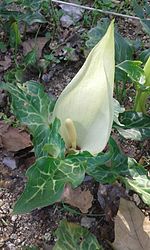Arum italicum
| Arum italicum | |
|---|---|

| |
| Scientific classification | |
| Kingdom: | Plantae |
| Clade: | Tracheophytes |
| Clade: | Angiosperms |
| Clade: | Monocots |
| Order: | Alismatales |
| Family: | Araceae |
| Genus: | Arum |
| Species: | A. italicum
|
| Binomial name | |
| Arum italicum | |
| Synonyms[1] | |
| |
Arum italicum is a species of flowering herbaceous perennial plant in the family Araceae, also known as Italian arum and Italian lords-and-ladies.[2] It is native to the British Isles[3] and much of the Mediterranean region, the Caucasus, Canary Islands, Madeira and northern Africa. It is also naturalized in Belgium, the Netherlands, Austria, Argentina, North Island New Zealand and scattered locations in North America.[1][4][5][6][7]
Description[edit]
It grows 30–46 cm (1–1.5 ft) high, with equal spread. It blooms in spring with white flowers that turn to showy red fruit.[2]
In 1778, Lamarck noticed that the inflorescence of this plant produces heat.[8][9]
Leaves, fruits and rhizomes contain compounds that make them poisonous. Notably, the plants are rich in oxalates. The ingestion of the plant may be fatal, as it affects the kidneys, digestive tract, and brain.[10]
Cultivation[edit]
It is cultivated as an ornamental plant for traditional and woodland shade gardens.[2] Subspecies italicum (the one normally grown in horticulture) has distinctive pale veins on the leaves, whilst subspecies neglectum (known as late cuckoo pint[11]) has faint pale veins, and the leaves may have dark spots.[12] Nonetheless, intermediates between these two subspecies also occur, and their distinctiveness has been questioned.[13][14] Some gardeners use this arum to underplant with Hosta, as they produce foliage sequentially: when the Hosta withers away, the arum replaces it in early winter, maintaining ground-cover.[15] Numerous cultivars have been developed for garden use, of which A. italicum subsp. italicum 'Marmoratum' has gained the Royal Horticultural Society's Award of Garden Merit.[16]
Invasive species[edit]
Arum italicum can be invasive in some areas, particularly in the Pacific Northwest of the United States.[15][17][18] It is very difficult to control once established. Herbicides kill the foliage of the plant, but may not affect the tuber. Manual control may spread the plants through the dissemination of soil contaminated with bulb and root fragments.[19]
Taxonomy[edit]
Within the genus, A. italicum belongs to subgenus Arum, section Arum.[20]
Arum italicum may hybridize with Arum maculatum.[21] The status of two subspecies currently included in Arum italicum, subsp. albispathum (Crimea to the Caucasus) and subsp. canariense (Macaronesia), is uncertain and they may represent independent species.[13]
A. italicum generally has a chromosome count of 2n = 84, except that a few subspecies (such as subsp. albispathum) have 2n = 56.[20]
Gallery[edit]
-
Bulbs
-
Mature leaves
-
Spathe
-
Ripe berries
-
Botanical illustration
-
Leaves of cultivar 'Marmoratum'
References[edit]
- "Arum italicum". Integrated Taxonomic Information System. Retrieved September 25, 2006.
- ^ a b "Arum italicum Mill". Plants of the World Online. Royal Botanic Gardens, Kew.
- ^ a b c MBG- hort. . accessed 11.1.2011
- ^ P.A. Stroh; T. A. Humphrey; R.J. Burkmar; O.L. Pescott; D.B. Roy; K.J. Walker (eds.). "Arum italicum Mill". BSBI Online Plant Atlas 2020. Retrieved 1 May 2023.
- ^ Govaerts, R. & Frodin, D.G. (2002). World Checklist and Bibliography of Araceae (and Acoraceae): 1-560. The Board of Trustees of the Royal Botanic Gardens, Kew.
- ^ Castroviejo, S. & al. (eds.) (2008). Flora Iberica 18: 1-420. Real Jardín Botánico, CSIC, Madrid.
- ^ Dobignard, D. & Chatelain, C. (2010). Index synonymique de la flore d'Afrique du nord 1: 1-455. Éditions des conservatoire et jardin botaniques, Genève.
- ^ Biota of North America Program, 2013 county distribution map
- ^ Meeuse, B.J.D. 1975. Films of liquid crystals as an aid in pollination studies. In Pollination and Dispersal, ed N.B.M. Brantjes, H.F. Linskens, pp 19-20. Nijmegen. The Netherlands: Dep. Botany, Univ. Nijmegen.
- ^ Wilhelm Pfeffer, The Physiology of Plants: A Treatise Upon the Metabolism and ..., Volume 3
- ^ Prakash Raju, K. N. J.; Goel, Kishen; Anandhi, D.; Pandit, Vinay R.; Surendar, R.; Sasikumar, M. (2018). "Wild tuber poisoning: Arum maculatum – A rare case report". International Journal of Critical Illness and Injury Science. 8 (2): 111–114. doi:10.4103/IJCIIS.IJCIIS_9_18. ISSN 2229-5151. PMC 6018264. PMID 29963416.
- ^ Late cuckoo pint at aphotoflora.com: retrieved 3 October 2020
- ^ C T Prime (1961). "Taxonomy and Nomenclature in Some Species of the Genus Arum L" (PDF). Watsonia. 5 (2): 106–9.
- ^ a b Boyce, P.C. (2002). "Arum - a Decade of Change". Aroideana. 29: 132–139.
- ^ Boyce, P.C. (2006). "New Observations on Arum italicum". The Plantsman. 5 (1): 36–39.
- ^ a b Clark County Master Gardeners Archived July 5, 2015, at the Wayback Machine
- ^ "RHS Plant Selector - Arum italicum subsp. italicum 'Marmoratum'". Retrieved 19 February 2020.
- ^ National Park Service, Exotic Plant Management Team
- ^ "Invasive Italian arum". West Multnomah Soil & Water Conservation District. Retrieved 2021-02-13.
- ^ "Control Options for Italian Arum". Whatcom County, Washington. Whatcom County Noxious Weed Board. Retrieved 18 February 2024.
- ^ a b Boyce, Peter (1993). The Genus Arum. London: HMSO. ISBN 0-11-250085-4.
- ^ Plantsman v13:3, p142, September 2014; Royal Horticultural Society
External links[edit]
- Missouri Botanical Garden - Kemper Center for Home Gardening - Arum italicum
- Invasive Plant Atlas Italian arum - Arum italicum






